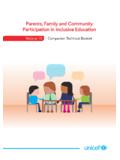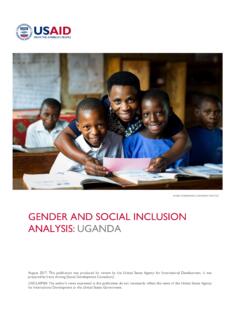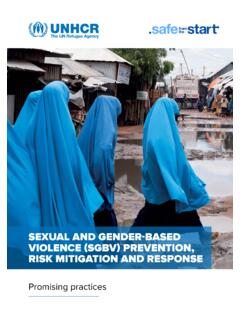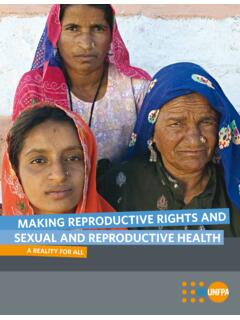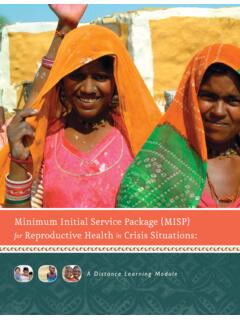Transcription of UNICEF Education Kit Handbook
1 Guidelines for Training of TrainersUNICEF Education Kit HandbookUNICEF Education Kit Handbook Guidelines for Training of TrainersiiiUNICEF Education Kit HandbookGuidelines for Training of TrainersINTRODUCTIONThe UNICEF Education in Emergencies (EiE) Handbook is a tool that provides training and curricular guidance in support of UNICEF pre-packaged Education kits. This is the first version of the Handbook and it has only been partially field tested. As such, all feedback is critical and welcome to help inform the planned revision. Please contact the Education Unit at UNICEF Supply Division with all relevant input, criticism and Handbook is available in French and English. Each Education kit shipped from Supply Division will contain the relevant module. Module One, the overall guidance module, is available upon request, or on the UNICEF website, along with all the other The Handbook was developed over eighteen months by UNICEF staff from the Programme Education sections in New York and Geneva and from Supply Division in Copenhagen.
2 This document was developed through a consultative process led by a consultant that was guided by a reference group composed of UNICEF staff from Country Offices, Regional Offices and HQ locations. It was also independently reviewed at various stages by other UNICEF staff. A special thank you goes to all those who supported this Managers: Ms Pilar Aguilar, Senior Education Adviser, UNICEF Geneva and Mr Chris Cormency, Chief, Water, Sanitation and Education Centre (WSEC), Supply Division, UNICEF CopenhagenWriter: Ms Miresi BusanaEdited, produced and distributed by WSEC. First Edition 2013 UNICEF Education Kit HandbookivGuidelines for Training of TrainersKEY TERMINOLOGY Definition of Child: The terms child and children refer to all children and young people from birth to 18 years of age, as specified in the UN Convention on the Rights of the Child.
3 If a particular age group of children is intended, this will be made clear in the text. Age groups: It is important to highlight that age groups can vary according to context and culture. Indicatively the Handbook targets the age groups below:1) Infants, toddlers and pre-school children approximately from birth to seven/eight years. 2) Young adolescents between ten and fourteen years. 3) Older adolescents between fifteen and nineteen years. 4) Youths are adolescents and young adults between the ages of fifteen and twenty-four years (Reference: United Nations definitions) Definition of Pupil(s) and Student(s): Terms pupil(s) and student(s) refer to children taught by a teacher. They are interchangeable. Definition of Instructor(s), Caregiver(s) and Teacher(s): The term instructor(s) refers to the personnel implementing the semi-structured recreational activities (Module Two).
4 The term caregiver(s) refers to the personnel implementing early childhood Education activities (Module Three). The term teacher(s) refers to the personnel implementing basic primary Education and primary mathematics and science Education (Module Four, Module Five and Module Six). NOTE Volunteers are non-paid members of the local community who voluntarily help in the implementation of the activities. They are not members of staff but they should sign a Code of Conduct. Definition of Trainer(s): The term trainer(s) refers to the personnel delivering the training to instructors, caregivers and teachers (Module One).Definition of Trainee(s): The term trainee(s) refers to those who receive training. They can be (1) the trainers during the Training of Trainers (TOT) or (2) the instructors, caregivers and/or teachers receiving the training from the trainers.
5 Definition of Child-Friendly Spaces/Environment(s): The term Child-Friendly Spaces/Environment(s) (CFS/Es) is used in a broad sense. It is important to highlight that there is a broad and developing literature on the definition(s) of CFS/Es that involves different disciplines. Also the terminology used to indicate CFS/Es can vary among agencies. In the Handbook the term CFS/Es can refer to: CFS/Es, which are places designed and operated in a participatory manner, where children affected by natural disasters or armed conflict can be provided with a safe environment, where integrated programming including play, recreation, Education , health, and psychosocial support can be delivered and information about services/supports is provided. Generally Child-Friendly Spaces refer to relatively short to medium term programme responses.
6 They are very often operated from tents and/or temporary structures ( in schools, under a tree or a vacant building). UNICEF , 2009, A Practical Guide for Developing Child-Friendly Spaces , vUNICEF Education Kit HandbookGuidelines for Training of Trainers Temporary Learning Spaces (TLS), which are set up in the immediate aftermath of an emergency. Alternative Learning Spaces (ALS), which can be set up just about anywhere according to the context. Alternative learning spaces can be churches, mosques, temples, community halls, rooms within the community chief s office, libraries, a compound, allocated land and an unused room in a private house or even a boat . UNICEF , 2009, Child Friendly Schools Manual , Chapter 4, Existing or rehabilitated schools.
7 Child Friendly Schools (CFS) as defined in the UNICEF , 2009, Child Friendly Schools Manual . Three key reference documents, which can be downloaded via the UNICEF website, provide further information on Child Friendly Spaces: (1) A Practical Guide for Developing Child-Friendly Spaces , UNICEF , 2009; (2) Guidelines for Child Friendly Spaces in Emergencies , 2011, Field-testing version developed and reviewed by the Global Education Cluster, Global Protection Cluster, INEE and IASC; (3) Child Friendly Schools Manual , UNICEF , 2009, New York. KEY GRAPHIC MARKS:The following icons aim at facilitating the comprehension of the text:1. KEY MESSAGE summarises important learning content in a TRAINING provides indications on how to convey the KEY MESSAGES during the training session.
8 3. NOTE indicates a suggestion, tip, encouragement, clarification and idea. 4. THINK invites readers to reflect on their own experience and context. 5. LEARNING OUTCOMES indicates what is expected to be learned. It can help in monitoring and evaluating the progress of learning. 6. TABLESare lists of items. 7. PICTURES are visual examples of key concepts described in the general contents and helps to visualise them all SAMPLES are examples of what teachers and caregivers are expected to YOUR ROLE summarises what is expected from the trainer in Module One and from the instructors, caregivers and teachers in Modules Two, Three, Four, Five and CASE STUDY are examples of Education interventions already CHECK LIST indicates important points to consider before and during the implementation of the the beginning of a new chapter in a unit.
9 NOTE UNICEF Education Kit HandbookviGuidelines for Training of TrainersINTRODUCTION TO TEXT1. Rationale of the EiE Handbook The right to Education is most at risk during emergencies and during the transition period following a crisis. In conflict-affected countries, 28 million children of primary school age were out of school in 2011 42 per cent of the world total. Only 79 per cent of young people are literate in conflict-affected countries, compared with 93 per cent in other poor countries. Moreover, children living in conflict are twice as likely to die before their fifth birthday as children in other poor countries. The Core Commitments for Children in Humanitarian Action the CCCs constitute UNICEF s central humanitarian policy to uphold the rights of children affected by humanitarian crisis.
10 They are a framework for humanitarian action, around which UNICEF seeks to engage with partners. The updated CCCs continue to promote predictable, effective and timely collective humanitarian action and to clearly outline the areas in which UNICEF can best contribute to results including addition, the Inter-Agency Network for Education in Emergencies (INEE) has developed the Minimum Standards Handbook . The Handbook is designed to give governments and humanitarian workers the tools they need to address the Education for All movement and the UN Millennium Development Goals (MDGs). It is the first step toward ensuring that Education initiatives in emergency situations provide a solid and sound basis for post-conflict and disaster reconstruction. Both instruments have been complementary and critical in the preparedness and response of the Inter-Agency Standing Committee (IASC) Humanitarian Reform launched in 2005 that established the Education cluster approach.










